 W
WThe Agar gun was an early rapid fire machine gun developed during the US Civil War. The weapon was nicknamed the Coffee Mill Gun, and was also called the Union Repeating Gun.
 W
WThe Beaumont–Adams revolver is a black powder, double-action, percussion revolver. Originally adopted by the British Army in .442 calibre in 1856, it was replaced in British service in 1880 by the .476 calibre Enfield Mk I revolver.
 W
WThe Billinghurst Requa Battery gun was an early rapid-fire gun used during the American Civil War. It was invented by a Dr. Josephus Requa (1833–1910), a dentist by profession, who had at the age of 16 spent three years as an apprentice to William Billinghurst (1807–1880), a New York riflemaker.
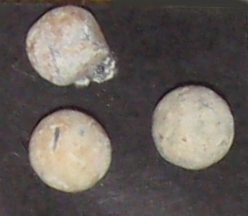 W
WBuck and ball was a common load for muzzle-loading muskets, and was frequently used in the American Revolutionary War and into the early days of the American Civil War. The load usually consisted of a .50 to .75 caliber round lead musket ball that was combined with three to six buckshot pellets.
 W
WThe coal torpedo was a hollow iron casting filled with explosives and covered in coal dust, deployed by the Confederate Secret Service during the American Civil War, and intended for doing harm to Union steam transportation. When it was shoveled into the firebox amongst the coal, the resulting explosion would at the very least damage the boiler and render the engines inoperable. At worst, a catastrophic boiler explosion would kill crewmen and passengers, start a fire, or even sink the vessel.
 W
WThe Colt Revolving Belt Pistol or Navy Pistol, sometimes erroneously referred to as "Colt Revolving Belt Pistol of Naval Caliber" or "of Navy Caliber", is a cap and ball revolver that was designed by Samuel Colt between 1847 and 1850. Colt first referred to this Revolver as the Ranger Size model, and then Revolving Belt, but the designation "Navy" quickly took over.
 W
WThe Colt Army Model 1860 is a cap & ball .44-caliber single-action revolver used during the American Civil War made by Colt's Manufacturing Company. It was used as a side arm by cavalry, infantry, artillery troops, and naval forces.
 W
WThe Colt Model 1848 Percussion Army Revolver is a .44 caliber revolver designed by Samuel Colt for the U.S. Army's Regiment of Mounted Rifles. The revolver was also issued to the Army's "Dragoon" Regiments. This revolver was designed as a solution to numerous problems encountered with the Colt Walker. Although it was introduced after the Mexican–American War, it became popular among civilians during the 1850s and 1860s, and was also used during the American Civil War.
 W
WThe Colt Model 1861 Navy cap & ball .36-caliber revolver was a six-shot, single-action percussion weapon produced by Colt's Manufacturing Company from 1861 until 1873. It incorporated the "creeping" or ratchet loading lever and round barrel of the .44-caliber Army Model of 1860 but had a barrel one half inch shorter, at 7.5 inches. Total production was 38,000 revolvers.
 W
WThe Colt Model 1855 Sidehammer, also known as the Colt Root Revolver after engineer Elisha K. Root (1808–1865), was a cap & ball single-action pocket revolver used during the American Civil War and made by the Colt's Patent Fire Arms Manufacturing Company
 W
WThe family of Colt Pocket Percussion Revolvers evolved from the earlier commercial revolvers marketed by the Patent Arms Manufacturing Company of Paterson, N.J. The smaller versions of Colt's first revolvers are also called "Baby Patersons" by collectors and were produced first in .28 to .31 caliber, and later in .36 caliber, by means of rebating the frame and adding a "step" to the cylinder to increase diameter. The .31 caliber carried over into Samuel Colt's second venture in the arms trade in the form of the "Baby Dragoon"-a small revolver developed in 1847–48. The "Baby Dragoon" was in parallel development with Colt's other revolvers and, by 1850, it had evolved into the "Colt's Revolving Pocket Pistol" that collectors now name "The Pocket Model of 1849". It is a smaller brother of the more famous "Colt's Revolving Belt Pistol of Naval Caliber" introduced the same year and commonly designated by collectors as the "1851 Navy Model". In 1855 Colt introduced another pocket percussion revolver, the Colt 1855 "Sidehammer", designed alongside engineer Elisha K. Root.
 W
WA cutlass is a short, broad sabre or slashing sword, with a straight or slightly curved blade sharpened on the cutting edge, and a hilt often featuring a solid cupped or basket-shaped guard. It was a common naval weapon during the early Age of Sail.
 W
WA derringer is a small handgun that is neither a revolver nor a semi/fully automatic pistol. It is not to be confused with mini-revolvers or pocket pistols, although some later derringers were manufactured with the pepperbox configuration. The modern derringer is often multi-barreled, and is generally the smallest usable handgun of any given caliber and barrel length due to the lack of a moving action, which takes up more space behind the barrel. It is frequently used by women because it is easily concealable in a purse or a stocking.
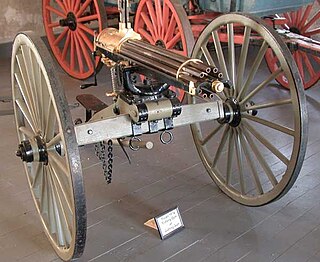 W
WThe Gatling gun is a rapid-firing multiple-barrel firearm invented in 1861 by Richard Jordan Gatling. It is an early machine gun and a forerunner of the modern electric motor-driven rotary cannon.
 W
WThe model 1805 U.S. Marshal "Harper's Ferry" flintlock pistol, manufactured at the Harpers Ferry Armory in Virginia, was the first pistol manufactured by an American national armory. It was the standard handgun of the US dragoons during the War of 1812.
 W
WKerr's Patent Revolver was an unusual 5-shot single-action revolver manufactured from 1859 to 1866 by the London Armoury Company. It was used by Confederate cavalrymen during the U.S. Civil War. Seven of these revolvers were held by the New Zealand Colonial Defence Force in 1863 and were issued to the famous Forest Rangers at the start of the campaign to push Maori rebels out of the Auckland province. It is easily recognized by its side-mounted hammer.
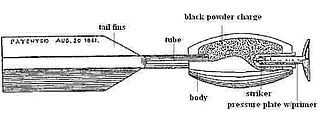 W
WThe Ketchum Hand Grenade was a type of grenade used in the American Civil War. It was patented on August 20, 1861 by William F. Ketchum, a mayor of Buffalo, N.Y., and was partially adopted in the Union Army. They were used in battles such as Vicksburg and Petersburg.
 W
WIn 1854, Frenchman Eugene Lefaucheux introduced the Lefaucheux Model 1854, notable as being the first revolver to use self-contained metallic cartridges rather than loose powder, pistol ball, and percussion caps. The M1854 model was a single-action, pinfire revolver holding six rounds. It was a French military revolver chambered for the 12 mm pinfire cartridge, based on a design by Casimir Lefaucheux. The M1854 revolver spawned numerous variants, some of which were produced under license in other countries. It was widely exported during the 1860s and sold as both a military and civilian sidearm with either a short or long barrel. Most military models were produced only with single-action whereas civilian models were made primarily with double action.
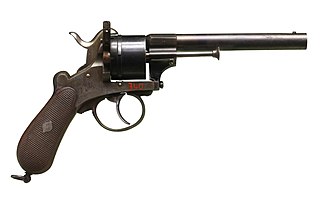 W
WThe Lefaucheux M1858 was a French military revolver developed for the navy, chambered for the 12 mm pinfire cartridge, and based on a design by Casimir Lefaucheux and his son, Eugene. The 1854 model was the first metallic-cartridge revolver adopted by a national government; the 1858 was the first variant fielded It was first issued in 1858 by the French Navy, and though never issued by the French Army, it was used in limited numbers by the French Cavalry during their 1862 deployment to Mexico. The 1858 was later upgraded in the late 1860s as the Lefaucheux de Marine 1870. It was accepted by the French Navy, but only 150 copies were delivered by 1872. Models of the 1858 were also purchased by Spain, Sweden, Italy, Russia, and Norway. Most were produced either at the state arsenal Manufacture d'armes de Saint-Étienne (MAS), Liège, Belgium, or local producers under license. The revolver was sold to the civilian market as well. Most military models were produced only with single-action, whereas civilian models were made primarily with double action.
 W
WThe LeMat revolver was a .42 or .36 caliber cap & ball black powder revolver invented by Jean Alexandre LeMat of New Orleans, which featured an unusual secondary 20 gauge smooth-bore barrel capable of firing buckshot. It saw service with the armed forces of the Confederate States of America during the American Civil War of 1861–65 and the Army of the Government of National Defense during the Franco-Prussian War.
 W
WThe American Civil War, fought between the Union and Confederate forces, took place from 1861 to 1865. During the war, a variety of weapons were used on both sides. These weapons include edged weapons such as knives, swords, and bayonets, firearms such as rifled muskets, breech-loaders and repeating weapons, various artillery such as field guns and siege guns and new weapons such as the early grenade and landmine.
 W
WA cutlass is a short, broad sabre or slashing sword, with a straight or slightly curved blade sharpened on the cutting edge, and a hilt often featuring a solid cupped or basket-shaped guard. It was a common naval weapon during the early Age of Sail.
 W
WThe Springfield Model 1816 was a .69 caliber flintlock musket manufactured in the United States during the early 19th century.
 W
WThe Springfield Model 1822 was a .69 caliber flintlock musket manufactured by the United States in the early 19th century.
 W
WThe Model 1832 foot artillery sword was a 25-inch (64 cm) short-sword with a straight, double-edged blade and brass-mounted leather scabbard.
 W
WThe Model 1840 noncommissioned officers' sword was adopted by the United States military in 1840. Based primarily on a sword used by the French Army, the model 1840 NCO proved somewhat heavy hilted and ill balanced. For over 70 years, it was widely used by the Army; today its usage is restricted to ceremonial occasions. The sword had a 31-inch blade, a cast brass hilt resembling the more expensive wire-wrapped leather grips, and a leather scabbard rather than the steel used by cavalry troopers and officers, although some makers, such as Emerson and Silver, issued a steel scabbard rather than leather to protect from wear. Leather scabbards were phased out beginning in 1868.
 W
WThe Model 1840 Cavalry Saber was based on the 1822 French hussar's sabre. Unlike its replacement, the Model 1860 Light Cavalry Saber the M1840 has a ridge around its quillon, a leather grip wrapped in wire and a flat, slotted throat. It is 44in long with a 35in blade and weighs roughly 2.5 lbs.
 W
WThe Model 1860 Light Cavalry Saber is a long sword made of steel and brass, used by US cavalry from the American Civil War until the end of the Indian wars; some were still in use during the Spanish–American War. It was 41 inches (104 cm) long with a 35 by 1 in blade and weighed 2 lb 4 oz (1.0 kg) alone or 3 lb 10 oz (1.6 kg) with iron scabbard.
 W
WA naval mine is a self-contained explosive device placed in water to damage or destroy surface ships or submarines. Unlike depth charges, mines are deposited and left to wait until they are triggered by the approach of, or contact with, any vessel. Naval mines can be used offensively, to hamper enemy shipping movements or lock vessels into a harbour; or defensively, to protect friendly vessels and create "safe" zones. Mines allow the minelaying force commander to concentrate warships or defensive assets in mine-free areas giving the adversary three choices: undertake an expensive and time-consuming minesweeping effort, accept the casualties of challenging the minefield, or use the unmined waters where the greatest concentration of enemy firepower will be encountered.
 W
WThe North-South Skirmish Association (N-SSA) is a historical and competitive organization whose goal is to maintain the knowledge of the unique firearms used during the American Civil War. Formed in 1950 to commemorate the men who fought on both sides during the war, the association is based mainly in the eastern United States, there are related associations in the western United States
 W
WThe pepper-box revolver or simply pepperbox is a multiple-barrel firearm, mostly in the form of a handgun, that has three or more gun barrels in a coaxially revolving mechanism. Each barrel holds a single shot, and the shooter can manually rotate the whole barrel assembly to sequentially index each barrel into alignment with the lock/hammer, similar to operating a revolver cylinder.
 W
WThe Remington-Beals Model Revolvers along with subsequent models and variations were percussion revolvers manufactured by Eliphalet Remington & Sons in .31 (Pocket) .36 (Navy) or .44 (Army) caliber, used during the American Civil War, and was the beginning of a successful line of medium and large frame pistols. They are commonly, though inaccurately, referred to as the Model 1858 due to the patent markings on its New Model barrels, "PATENTED SEPT. 14, 1858/E. REMINGTON & SONS, ILION, NEW YORK, U.S.A./NEW MODEL."; although wide scale production did not start until 1861.
 W
WThe Remington-Rider Single Shot Derringer Parlor Pistol was made by E. Remington and Sons between 1860 and 1863. Only two hundred were produced.
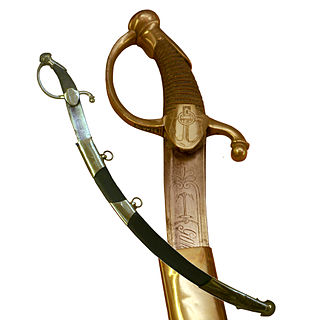 W
WA sabre is a type of backsword with a curved blade associated with the light cavalry of the early modern and Napoleonic periods. Originally associated with Central European cavalry such as the hussars, the sabre became widespread in Western Europe in the Thirty Years' War. Lighter sabres also became popular with infantry of the early 17th century. In the 19th century, models with less curving blades became common and were also used by heavy cavalry.
 W
WThe Savage 1861 Navy was a cap and ball revolver manufactured by the Savage Revolving Firearms Company from 1861 to 1862. This company is unrelated to the later Savage Arms Company. It was used by both sides during the American Civil War.
 W
WThe Smith & Wesson Model No. 2 Army a.k.a. Model No. 2 Old Model Smith & Wesson Revolver was Smith & Wesson's first .32 caliber revolver, intended to combine the small size and convenience of the Smith & Wesson Model 1 .22 rimfire with a larger caliber. Chambered in the .32 rimfire long caliber, its cylinder held 6 shots. It was manufactured 1861 - 1874, with a total production of 77,020.
 W
WSmith & Wesson Brands, Inc. (S&W) is an American manufacturer of firearms, ammunition and restraints. The corporate headquarters is in Springfield, Massachusetts.
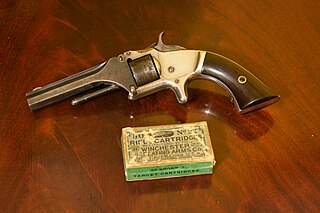 W
WThe Smith & Wesson Model 1 was the first firearm manufactured by Smith & Wesson, with production spanning the years 1857 through 1882. It was the first commercially successful revolver to use rimfire cartridges instead of loose powder, musket ball, and percussion caps. It is a single-action, tip-up revolver holding seven .22 Short black powder cartridges.
 W
WA spar torpedo is a weapon consisting of a bomb placed at the end of a long pole, or spar, and attached to a boat. The weapon is used by running the end of the spar into the enemy ship. Spar torpedoes were often equipped with a barbed spear at the end, so it would stick to wooden hulls. A fuse could then be used to detonate it.
 W
WThe Springfield Model 1840 was a flintlock musket manufactured by the United States during the mid-19th century. The .69 caliber musket had a 42-inch (107 cm) barrel, an overall length of 58 inches (147 cm), and a weight of 9.8 pounds (4.4 kg). More than 30,000 were produced by the Springfield and Harpers Ferry armories and two independent contractors between 1840 and 1846.
 W
WThe Springfield Model 1842 was a .69 caliber musket manufactured and used in the United States during the mid-19th century. It is a continuation of the Springfield Model 1816 line of muskets but is generally referred to as its own model number rather than just a variant of the Model 1816.
The Springfield Model 1855 was a rifle musket widely used in the American Civil War. It exploited the advantages of the new conical Minié ball, which could be deadly at over 1,000 yards. About 60,000 of these rifles were made, and it was a standard infantry weapon for Union and Confederates alike, until the Springfield Model 1861 supplanted it, obviating the use of the insufficiently waterproof Maynard tape primer.
 W
WThe Springfield Model 1861 was a Minié-type rifled musket shoulder-arm used by the United States Army and Marine Corps during the American Civil War. Commonly referred to as the "Springfield", it was the most widely used U.S. Army weapon during the Civil War, favored for its range, accuracy, and reliability.
 W
WThe Springfield Model 1863 was a .58 caliber rifled musket manufactured by the Springfield Armory and independent contractors between 1863 and 1865.
 W
WA Starr revolver is a double-action revolver which was used in the western theater of the American Civil War until the U.S. Ordnance Department persuaded the Starr Arms Co. to create a single-action variant after discontinuation of the Colt. The company eventually complied, and the Union acquired 25,000 of the single-action revolvers for $12 each. However, the price paid by the government for the DA army revolver was $25. The State of Ohio purchased 500 of the .36 Caliber Navy version for $20 each.
 W
WThe Teat-fire cartridge was a .32 caliber pistol cartridge designed by Daniel Moore and manufactured by Moore and his partner David Williamson for their Pocket Revolver and was produced under both the Moore and National Arms marques by the National Arms Company of Brooklyn, New York in the mid-19th century.
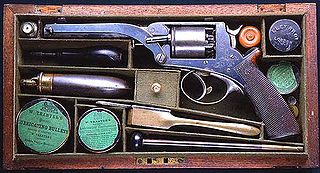 W
WThe Tranter revolver was a double-action cap & ball revolver invented around 1856 by English firearms designer William Tranter (1816–1890). Originally operated with a special dual-trigger mechanism later models employed a single-trigger mechanism much the same as that found in the contemporary Beaumont–Adams revolver.
 W
WThe Marine Corps noncommissioned officer's sword is a sword worn by noncommissioned officers (NCOs) and staff noncommissioned officers (SNCOs) of the United States Marine Corps. The NCO sword was adopted in 1859 and is patterned after the United States Army's foot officers' sword of 1850. The M1859 NCO sword continues service today as the Marine Corps drill and ceremonial sword. The sword's use is restricted by regulation to ceremonial occasions by an NCO or Staff NCO in charge of troops under arms or at weddings and wedding receptions where at least one of those being married is in uniform and has the rank of Corporal or higher.
 W
WUSMC Sword Manual Procedures are commonly used in the Marine Corps. Marines considered Non-commissioned Officers (NCO) as well as Staff Non-Commissioned Officers (SNCO) may find themselves having to perform "Sword Manual", which is a stationary drill.
 W
WThe Volcanic Repeating Arms Company was an American company formed in 1855 by partners Horace Smith and Daniel B. Wesson to develop Walter Hunt's Rocket Ball ammunition and lever action mechanism. Volcanic made an improved version of the Rocket Ball ammunition, and a carbine and pistol version of the lever action gun to fire it. While the Volcanic Repeating Arms Company was short lived, its descendants, Winchester Repeating Arms Company and Smith & Wesson became major firearms manufactures.
 W
WThe Walch Revolver is a .36 caliber cap and ball black powder revolving action handgun, designed by Walch Firearms & Co. The revolver was patented in 1859 by John Walch.
 W
WThe Winans Steam Gun was a steam-powered centrifugal gun used during the American Civil War, which used centrifugal forces to propel projectiles.